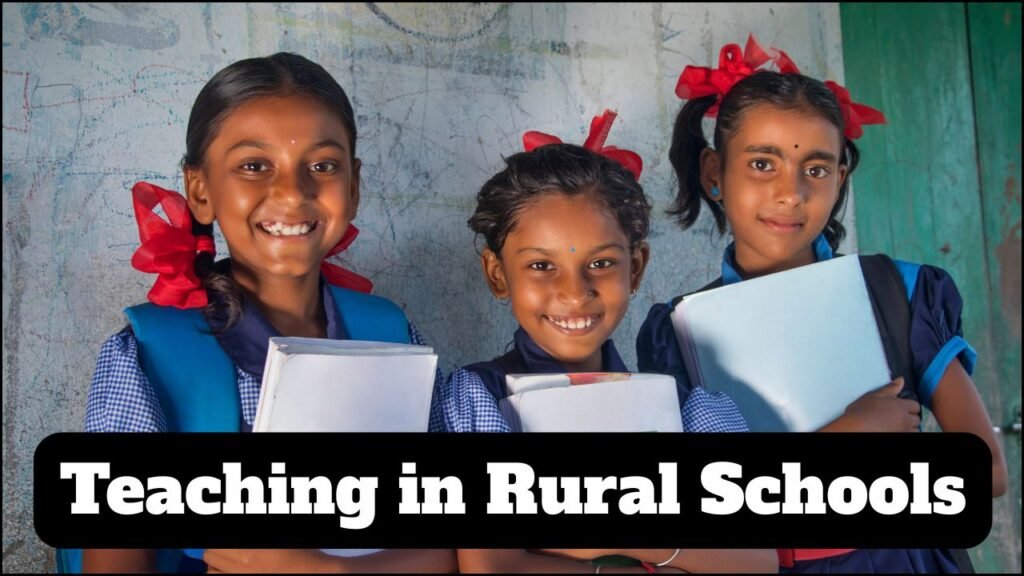
Teaching in rural schools brings both unique challenges and important opportunities. These schools often serve communities where access to quality education is limited. Teachers working in rural areas must manage with fewer resources, long travel distances, and social barriers. However, their contribution plays a big role in shaping the future of rural youth. This article explores real challenges faced in rural teaching and gives practical solutions to improve the education system in these areas.
Table of Contents
Major Challenges in Rural Teaching
Limited Infrastructure
- Poor building conditions create an uncomfortable learning space.
- Lack of electricity, clean water, and proper toilets affects both students and teachers.
- Inadequate classroom furniture leads to poor sitting arrangements.
Teacher Shortage
- Fewer teachers result in high student-teacher ratios.
- Multi-grade teaching is common due to a lack of subject specialists.
- Frequent transfers and absenteeism affect learning continuity.
Transport and Accessibility Issues
- Remote locations are difficult to reach, especially during monsoon or winter.
- Lack of public transport affects teacher punctuality and student attendance.
- Teachers often walk long distances to reach school.
Lack of Digital Tools
- Many schools lack internet access and digital teaching aids.
- Absence of smart classrooms limits innovative teaching practices.
- Poor digital literacy among teachers and students slows progress.
Low Community Awareness
- Parents often give low priority to education.
- Students are pushed into farm work or household chores.
- Gender bias leads to fewer girls attending school regularly.
Language Barriers
- Students in tribal or non-Hindi-speaking areas struggle with the curriculum.
- Textbooks are often not available in local dialects.
- Teachers unfamiliar with the local language face communication gaps.
Irregular Student Attendance
- Seasonal migration affects student enrollment.
- Economic pressure leads students to drop out to work.
- Long distances discourage daily school visits.
Lack of Training and Support
- Teachers receive limited training for handling rural challenges.
- Infrequent monitoring leads to poor teaching quality.
- No support for mental well-being or stress management.
Common Problems in Rural Schools: Overview
| Challenge | Description |
|---|---|
| Infrastructure | Poor buildings, no toilets, no electricity |
| Teacher Availability | Few teachers, multi-grade teaching |
| Transport | Long distances, no buses, tough terrain |
| Digital Gap | No internet, no smartboards, low computer use |
| Parental Involvement | Parents are unaware of the value |
| Language Issues | Curriculum not in the native language |
| Attendance | Irregular due to migration and chores |
| Training Deficit | Teachers lack exposure to modern methods |
Practical Solutions for Improvement
Strengthening Infrastructure
- Government funding must focus on school buildings, water supply, and sanitation.
- Solar panels can offer electricity where the grid is missing.
- Locally-made furniture can improve classroom comfort affordably.
Recruiting and Retaining Teachers
- Rural service incentives should be provided, like housing and extra pay.
- Hiring from local communities can reduce transfer issues and absenteeism.
- Support networks and peer groups can keep teachers motivated.
Providing Better Transport
- Bicycle or vehicle subsidies should be given to rural students.
- School buses must be arranged in the most remote villages.
- Community volunteers can assist in ensuring student safety during travel.
Introducing Digital Education
- Mobile tablets with preloaded content can be distributed.
- Offline digital tools can help where the internet is unavailable.
- Teachers should receive training in basic digital teaching tools.
Raising Awareness in the Community
- Door-to-door campaigns can promote the value of education.
- Mothers’ groups and local leaders can influence community attitudes.
- Regular parent-teacher meetings can improve trust and communication.
Bridging the Language Gap
- Learning materials should be prepared in local languages.
- Teachers must be trained in bilingual teaching techniques.
- Peer learning and story-based teaching can enhance understanding.
Improving Attendance
- Mid-day meal schemes should be maintained and improved.
- Scholarships and free uniform programs can encourage regular attendance.
- Special classes can help students who miss school due to migration.
Capacity Building for Teachers
- Regular training workshops should be organized in local languages.
- Mentorship from experienced educators can guide new teachers.
- Feedback from students and parents can help teachers adapt better.
Solutions Comparison
| Challenge | Solution |
|---|---|
| Poor Infrastructure | Build toilets, provide water, and set up solar electricity |
| Few Teachers | Hire locally, offer rural bonuses |
| Access Issues | Provide transport support, and involve local volunteers |
| Lack of Technology | Use offline digital content, train teachers |
| Low Awareness | Community campaigns, PTMs, involve local leaders |
| Language Barriers | Use bilingual content, train in local dialects |
| Irregular Attendance | Mid-day meals, free uniforms, flexible learning schedules |
| Training Gaps | Monthly workshops, mentorship, peer learning |
Successful Rural Education Models in India
Barefoot Teachers of Rajasthan
- Local women trained as community teachers.
- Teach basic literacy and numeracy to young children.
- Focus on flexibility and cultural understanding.
Pratham’s Village Learning Programs
- Use volunteers to run learning camps.
- Simple tools and story-based teaching.
- Focus on foundational learning outcomes.
Ekal Vidyalayas
- Single-teacher schools in remote villages.
- Emphasis on value education, hygiene, and basic skills.
- Strong community support ensures sustainability.
Policy Support Required
Stronger Funding
- Budgets must prioritize rural schools for at least 30% of state funds.
- Private-public partnerships can support infrastructure and training.
Decentralized Governance
- Local bodies should manage rural school affairs.
- Regular school inspections must be conducted.
Flexible Curriculum
- Activity-based and local-contextual content should be added.
- Vocational skills must be included from middle school.
Monitoring and Accountability
- Monthly school reports must be reviewed at the district level.
- Parent committees can take part in school improvement plans.
Benefits of Solving Rural Education Issues
| Impact Area | Benefits |
|---|---|
| Student Performance | Better scores, reduced dropouts |
| Teacher Satisfaction | Improved morale and retention |
| Community Development | Better literacy and employment outcomes |
| National Growth | Skilled rural population boosts economy |
Wrapping Up
Teaching in rural schools demands patience, creativity, and strong support systems. Real progress depends on improving infrastructure, training teachers, engaging communities, and ensuring access to modern tools. With thoughtful planning and consistent efforts, education in rural India can be transformed into a powerful tool for equality and growth.





